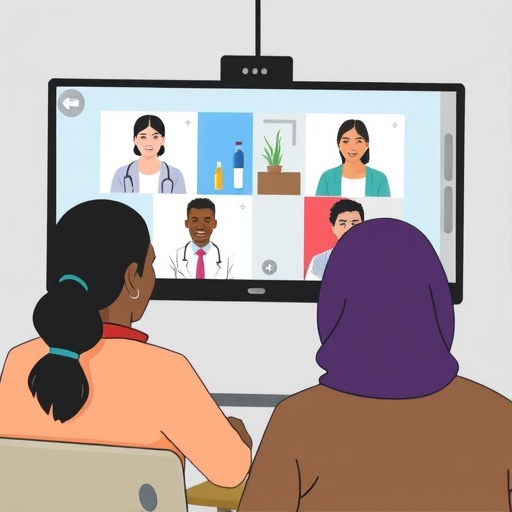As the healthcare landscape continues to evolve, the emergence of telehealth has redefined the traditional way patients interact with healthcare providers. Telehealth offers significant advantages, particularly for patients in remote areas or those with mobility limitations. However, it brings unique challenges, especially for individuals with non-English language preferences. The qualitative study by Kong and Fernandez sheds light on this critical issue, focusing on the perspectives of clinic personnel regarding the barriers that hinder effective video visits for these patients.
Clinics across the globe have increasingly turned to virtual consultations, yet not all patients experience equal access. The study’s findings reveal that language barriers remain one of the most daunting obstacles in providing optimal telehealth services. For non-English speakers, the inability to communicate effectively during video visits can lead to misunderstandings, inadequate care, and reduced patient satisfaction. Understanding these barriers is crucial for improving the efficiency and inclusivity of telehealth practices.
The research highlights the multifaceted nature of language-related challenges faced by clinic personnel. Many providers report discomfort when attempting to communicate with non-English speaking patients. This discomfort often stems from a lack of confidence in their language skills or insufficient resources to facilitate effective communication. As a result, clinic personnel may resort to using family members as interpreters or rely on ad hoc translation tools, neither of which adequately addresses the complexities of medical conversations.
Moreover, the disparity in language fluency between patients and healthcare providers can exacerbate feelings of alienation for non-English speakers. Patients may feel unsupported or undervalued when they perceive their needs are not fully understood or acknowledged. This perception can discourage them from seeking care altogether, thus compromising their health outcomes. The emotional toll of navigating a healthcare system that often fails to accommodate non-English speakers is a significant topic that demands attention.
Additionally, technological barriers also pose challenges for non-English speakers during video visits. Many clinics utilize software and platforms that are predominantly English-based. Patients who are not proficient in English may struggle with navigating these technological tools, leading to frustrations that further impede their ability to engage meaningfully in their healthcare. This technological divide can inadvertently perpetuate health disparities and undermine the potential benefits of telehealth.
The study emphasizes the importance of training clinic personnel to effectively navigate these complexities. By equipping healthcare providers with the skills and resources necessary to communicate with non-English speaking patients, clinics can foster a more inclusive environment. Training can range from offering language courses to providing cultural competency workshops that underscore the importance of understanding diverse patient backgrounds.
Interpreting services are also highlighted in the research as a pivotal resource for overcoming communication barriers. Many clinics lack access to professional interpreters during video visits, which can result in incomplete or inaccurate exchanges of information. Integrating professional interpretation services into telehealth platforms can dramatically enhance the quality of care delivered to patients with non-English language preferences, ensuring that they receive the same standard of care as their English-speaking counterparts.
Furthermore, the incorporation of technology-driven solutions may alleviate some of these challenges. Machine translation and artificial intelligence could play a significant role in facilitating communication. However, the study cautions against relying solely on these technologies, as they may not always capture the nuances of medical terminology or cultural context. Striking a balance between human interpretation and technological assistance could pave the way toward more effective communication.
The research points to the critical need for healthcare systems to address these barriers from an administrative and policy perspective. By prioritizing language access in telehealth initiatives, decision-makers can ensure that equitable care is accessible to all patients, regardless of their language proficiency. Policies fostering multilingual support within healthcare settings can drive substantial improvements in patient engagement and outcomes.
Kong and Fernandez’s findings call for heightened awareness and action among healthcare leaders, urging them to consider the implications of language barriers in telehealth. By forming partnerships with community organizations that serve non-English speaking populations, clinics can reach those in need and gather invaluable insights into their experiences. This collaboration can yield innovative solutions tailored to the unique challenges faced by these communities.
In conclusion, as telehealth continues to shape the future of healthcare, it is imperative to recognize and address the barriers faced by non-English speaking patients. Providing training for clinic personnel, enhancing access to professional interpreting services, and integrating technology are all essential steps in creating a more inclusive healthcare experience. The perspectives shared in Kong and Fernandez’s study highlight the need for continued dialogue and action to ensure that all patients, regardless of their language abilities, receive the quality care they deserve.
Ultimately, overcoming these barriers will not only improve the patient experience but also enhance overall health outcomes. By fostering an environment of inclusion and understanding, the healthcare industry can harness the full potential of telehealth to serve diverse patient populations effectively.
Subject of Research: Barriers to Video Visits for Non-English Language Preferences
Article Title: Clinic Personnel Perspectives on Barriers to Video Visits for Patients with Non-English Language Preferences: A Qualitative Study
Article References:
Kong, M., Fernandez, A. Clinic Personnel Perspectives on Barriers to Video Visits for Patients with Non-English Language Preferences: A Qualitative Study. J GEN INTERN MED (2025). https://doi.org/10.1007/s11606-025-09864-1
Image Credits: AI Generated
DOI:
Keywords: Telehealth, Non-English Speakers, Language Barriers, Video Visits, Healthcare Inclusivity.




